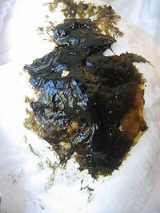
Meconium
Overview
Meconium is the earliest stools
of an infant
. Unlike later feces, meconium is composed of materials ingested during the time the infant spends in the uterus
: intestinal epithelial cells, lanugo
, mucus
, amniotic fluid
, bile
, and water. Meconium is almost sterile, unlike later feces, is viscous and sticky like tar, and has no odor. It should be completely passed by the end of the first few days of life, with the stools progressing toward yellow (digested milk).
Human feces
Human feces , also known as a stool, is the waste product of the human digestive system including bacteria. It varies significantly in appearance, according to the state of the digestive system, diet and general health....
of an infant
Infant
A newborn or baby is the very young offspring of a human or other mammal. A newborn is an infant who is within hours, days, or up to a few weeks from birth. In medical contexts, newborn or neonate refers to an infant in the first 28 days after birth...
. Unlike later feces, meconium is composed of materials ingested during the time the infant spends in the uterus
Uterus
The uterus or womb is a major female hormone-responsive reproductive sex organ of most mammals including humans. One end, the cervix, opens into the vagina, while the other is connected to one or both fallopian tubes, depending on the species...
: intestinal epithelial cells, lanugo
Lanugo
Lanugo is fine, downy hair as a type of fur. It is often found in teratomas .-Fetal development:Lanugo grows on fetuses as a normal part of gestation, but is usually shed and replaced by vellus hair at about 33 to 36 weeks of gestational age...
, mucus
Mucus
In vertebrates, mucus is a slippery secretion produced by, and covering, mucous membranes. Mucous fluid is typically produced from mucous cells found in mucous glands. Mucous cells secrete products that are rich in glycoproteins and water. Mucous fluid may also originate from mixed glands, which...
, amniotic fluid
Amniotic fluid
Amniotic fluid or liquor amnii is the nourishing and protecting liquid contained by the amniotic sac of a pregnant woman.- Development of amniotic fluid :...
, bile
Bile
Bile or gall is a bitter-tasting, dark green to yellowish brown fluid, produced by the liver of most vertebrates, that aids the process of digestion of lipids in the small intestine. In many species, bile is stored in the gallbladder and upon eating is discharged into the duodenum...
, and water. Meconium is almost sterile, unlike later feces, is viscous and sticky like tar, and has no odor. It should be completely passed by the end of the first few days of life, with the stools progressing toward yellow (digested milk).
Unanswered Questions

